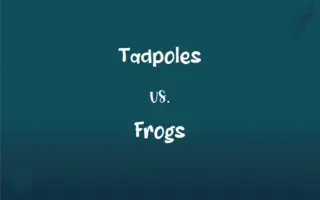Carburizing vs. Carbonitriding: What's the Difference?
Edited by Aimie Carlson || By Janet White || Updated on December 20, 2023
"Carburizing" is a heat treatment process adding carbon to the surface of steel, while "carbonitriding" adds both carbon and nitrogen, typically at lower temperatures.

Key Differences
Carburizing involves infusing the outer layer of steel with carbon to increase hardness. Carbonitriding, a similar process, incorporates both carbon and nitrogen into the surface, offering different mechanical properties.
In carburizing, the steel is heated in a carbon-rich environment, allowing carbon atoms to diffuse into the surface. Carbonitriding involves a lower temperature than carburizing, introducing nitrogen along with carbon for a more robust surface layer.
The purpose of carburizing is to create a hard, wear-resistant surface while maintaining a softer, ductile core. Carbonitriding, while also hardening the surface, is better suited for parts that require higher surface fatigue and wear resistance.
Carburizing is typically used for parts that need high surface hardness and a strong core, like gears. Carbonitriding is often applied to smaller, thinner parts that require enhanced strength and hardness without brittleness.
The depth of carbon penetration in carburizing can be controlled for specific applications. In carbonitriding, the addition of nitrogen allows for a shallower and harder case, suitable for specific engineering needs.
ADVERTISEMENT
Comparison Chart
Added Elements
Carbon.
Carbon and nitrogen.
Process Temperature
Higher temperatures.
Lower temperatures.
Application
Larger parts needing hard surface and tough core.
Smaller, thinner parts requiring strength and wear resistance.
Depth of Hardening
Deeper carbon penetration.
Shallower and harder surface case.
Material Properties
Increased surface hardness, ductile core.
Enhanced surface hardness, improved wear resistance.
ADVERTISEMENT
Carburizing and Carbonitriding Definitions
Carburizing
A heat treatment process that adds carbon to the surface of steel.
The gears were strengthened through carburizing.
Carbonitriding
A heat treatment process adding carbon and nitrogen to steel.
Carbonitriding was used to harden the surface of the small parts.
Carburizing
Enhancing steel's surface hardness by infusing carbon.
Carburizing the steel improved its wear resistance.
Carbonitriding
Infusing steel's surface with carbon and nitrogen at lower temperatures.
They chose carbonitriding for its lower processing temperature.
Carburizing
A method to create a hard surface over a ductile steel core.
Carburizing is ideal for parts requiring a tough exterior.
Carbonitriding
Enhancing steel's surface properties with carbon and nitrogen.
The surface wear resistance was improved by carbonitriding.
Carburizing
Heating steel in a carbon-rich atmosphere.
They used a furnace for the carburizing process.
Carbonitriding
A method for creating a thin, hard layer on steel.
Carbonitriding provided the thin parts with a hard, durable surface.
Carburizing
A treatment to increase steel's surface strength.
Carburizing was chosen to prolong the component's lifespan.
Carbonitriding
A treatment to improve steel's fatigue resistance.
The tools underwent carbonitriding for better fatigue resistance.
Carburizing
To treat, combine, or impregnate with carbon, as when casehardening steel.
Carbonitriding
Present participle of carbonitride
Carburizing
To carburet.
Carburizing
Present participle of carburize
FAQs
How does carburizing work?
It involves heating the steel part in a carbon-rich environment, allowing carbon atoms to diffuse into the surface.
What are the main types of carburizing?
Gas, liquid (pack), and vacuum carburizing.
What is the temperature range for carburizing?
Typically between 900°C to 950°C (1652°F to 1742°F).
What materials are suitable for carburizing?
Low-carbon steels are typically used for carburizing to achieve a hard surface with a tough core.
What is carburizing?
Carburizing is a heat treatment process that introduces carbon into the surface layer of a steel part to increase its hardness.
What are the applications of carburizing?
It's commonly used for gears, bearings, and other components requiring high surface hardness.
What is carbonitriding?
Carbonitriding is similar to carburizing but also introduces nitrogen into the steel to enhance surface hardness.
What materials are best for carbonitriding?
Low to medium-carbon steels are ideal for this process.
What are the applications of carbonitriding?
Used for small, intricate parts like screws, bolts, and other fasteners.
How deep does carburizing affect the material?
It generally affects up to 1-2.5mm of the surface, depending on the process duration and temperature.
Is carburizing expensive?
The cost varies, but it's generally more affordable than some other hardening techniques.
Can carburizing cause distortion?
Yes, it can cause slight distortions, which are usually corrected through post-treatment machining.
How does nitrogen affect the steel in carbonitriding?
Nitrogen enhances wear resistance and improves surface hardness.
Is post-treatment necessary after carbonitriding?
Yes, usually quenching and sometimes tempering are required.
Can carbonitriding be used on cast iron?
It's not commonly used on cast iron due to its lower effectiveness compared to steel.
How does carbonitriding improve part performance?
It increases surface hardness, wear resistance, and fatigue strength.
How is the hardness of carburized steel tested?
Using hardness testing methods like Rockwell or Vickers hardness tests.
What is the temperature range for carbonitriding?
Typically between 800°C to 850°C (1472°F to 1562°F).
How deep is the effect of carbonitriding on the material?
Generally up to 0.75mm, less than carburizing.
How is carbonitriding different from carburizing?
It involves both carbon and nitrogen, and is conducted at lower temperatures compared to carburizing.
About Author
Written by
Janet WhiteJanet White has been an esteemed writer and blogger for Difference Wiki. Holding a Master's degree in Science and Medical Journalism from the prestigious Boston University, she has consistently demonstrated her expertise and passion for her field. When she's not immersed in her work, Janet relishes her time exercising, delving into a good book, and cherishing moments with friends and family.
Edited by
Aimie CarlsonAimie Carlson, holding a master's degree in English literature, is a fervent English language enthusiast. She lends her writing talents to Difference Wiki, a prominent website that specializes in comparisons, offering readers insightful analyses that both captivate and inform.







































































